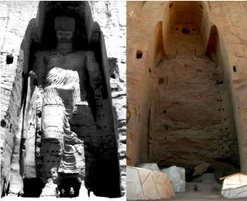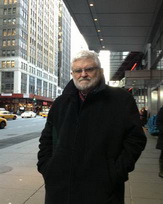The turbulence in
Iraq
and
Syria
and the emergence of the Islamic Republic has produced so
many accounts of pain, confusion and killing, carried through in acts of
vengeance and sheer brutality. The fear and anguish of those who have suffered
can only be unavoidably imagined.
Now in the last few days we
have seen the wanton destruction of ancient statues and early written texts in
the museum of the city of
Mosul
. With sledge hammers power tools and pick axes, the images
were toppled and reduced to rubble on the floor, the manuscripts burned.
Irreplaceable.
Many Iraqis evoke a popular
saying about the loss of non-human objects: 'May the books be a sacrifice for
the people.'
This is but the latest
incident in the human history of iconoclastic events over the years. During the
Byzantine era, the systematic destruction of early Christian images took place;
very few examples survived. In the Monastery of St Catherine in the
Sinai
Desert
there are some examples of icons, possibly from the 5th/6th
Centuries, but nothing compared to the number that were destroyed.
Much nearer our own time,
when the Reformation was gathering pace in
Europe
, images in churches and wall paintings of biblical scenes
were not tolerated. The statues were destroyed and the walls painted over. A
plain, sparse church building was the result. Given the number of parish
churches there must have been in
England
alone, a great deal has been lost. Now and then in a church
from this period, fragments are found when the whitewash is removed. Of the
statues, there is no trace.
In more recent times, in
2001, we witnessed the demolition of the Buddhas at Bamiyan in
Afghanistan
by the Taliban. The two huge images had been carved from the
rock in the mid-500s and had stood in the silence of the desert for nearly 1500
years, near to the
Silk Road
that runs through the
Hindu Kush
mountains. Now they are gone. An empty space remains where
once they stood.

A few days after those events
in March, 2001, I wrote these lines
The
breaking of statues
Still
shapes of some significance
whose
form, full fashioned
from
cliff-face rock
may
have a deeper meaning
and
understanding
beyond
artistic expression.
For
there, after the silence
of
stilled hands, brittle-boned
and
now returned to the earth,
they
left statues gazing
to
the sky, the sun and the stars,
speechless
yet speaking
of
each restless spirit moving
through
stages of completion.
There
they remained until came
the
time for the breaking of statues,
the
deliberate reduction
of
sand-blown curves
and
towering ancient presence
to
fine fragments
of
no particular meaning,
the
re-arrangement of sacred stone
in
the dust of the desert floor.
The
murderous treatment that we have seen in recent weeks in an attempt to subjugate
people and enforce control through fear has filled our screens and newspapers,
evil acts that belie the Moslem faith. To
destroy the historical and sacred links with their past only adds to their
indignity.
This
loss, from the cradle of civilisation, is a loss to the heritage of all
humanity.
END
----------
![]()

![]()